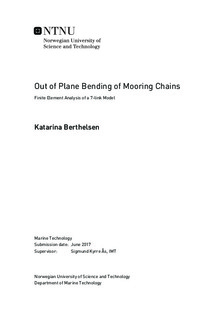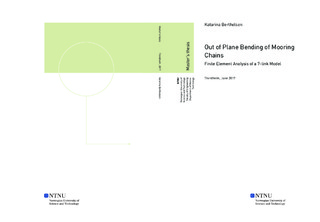| dc.description.abstract | This master's thesis is an investigation of out of plane bending (OPB) as a failure mode connected to the upper chain section of offshore mooring lines. A comprehensive literature study was done to present the OPB mechanism, findings from previous research, coverage of OPB within class rules and standards in the industry, as well as OPBs effect on offshore operations. For the latter purpose, eleven independent incident reports were reviewed where three listed OPB as main cause of line failure.
When offshore chain links are manufactured, a proof load representing 65 % to 80 % of minimum breaking load is applied to all links. This is done to prevent elongation during operation and creates a permanently deformed surface at the contact area between two adjacent links restricting interlink rotation, rolling, and sliding. Out of plane bending occurs when a chain link is bent out of its main plane because of resisted OPB-moments and transverse forces from link contact friction. If stresses are sufficient, crack propagation can occur at the first moving link leading to early failure. The interlink contact stiffness is studied by plotting the interlink angles between two adjacent links against the OPB moment appearing the link bent out of plane. In such plots, the three interlink motions can be identified. Sticking represents a linear increase of the OPB moment, whereas the moment remains constant when sliding motion has commenced. Rolling represents the increasingly nonlinear part of the curve. Investigation of out of plane bending is done by performing full-scale tests and supporting the results by FEA.
As offshore operations are moving further offshore, comprehensive mooring systems, larger chain links, higher pretensions, longer lines, and new operative environments are subsequently introduced. OPB is a failure mode that has received increased attention over the past decade, but the industry still suffers from gaps within scientific literature as well as safety standards.
The main part of the thesis was the development of an FE-model in ABAQUS CAE to investigate the OPB mechanism. The model was used to replicate full-scale tests recently done by DNV GL. These tests included seven chain links of R4 Ø = 175 mm, where chain links of this size have not been investigated previously. An OPB JIP completed in 2016 investigated R4 Ø 146 mm chain links and concluded with FEA being an effective method to study OPB and the interlink contact stiffness, but will continue to provide sub-conservative results. This conclusion was drawn from several sources of scatter discovered in the result data. FE-software has difficulties reproducing the real conditions in the locking area, a factor dependent on friction and material properties as well as material hardening during loading and unloading of proof load. The interlink stiffness will further be dependent on if locking occurs within or outside the plastic mating area. The pretension in the line will also influence OPB, affecting the lines independently. This makes OPB a single line, single link problem for a mooring analysis.
The full-scale test results are confidential and DNV GL did their own comparison to validate obtained FEA results from the thesis. They concluded that the results were replicating the behavior of the chain during testing in a good way. The FE-model was further used in a parameter study, investigating the effect of friction coefficient µ, operative tension (T), and proof loading (% of MBL). The sensitivity of the contact area was proven by a mesh convergence test, where a refinement of the element size at contact resulted in scatter of measured stress values, contact area size, and geometric deformation.
Obtained FEA results have proven that the model is behaving as expected when simulating submerged and dry conditions. The interlink stiffness curves are identical up until a certain angle, where the sliding threshold is reached more rapidly in water due to a lower friction coefficient. It was also proven that the operative pretension influenced the interlink stiffness, as an increase of tensile load lead to increased friction at the contact surface. By increasing the proof load, the length of the contact area at the link boundary was subsequently increased resulting in a stiffer interlink stiffness. An increase from 70 % to 73 % of MBL increased the interlink stiffness from 52 to 65.5 kNm per degree angle at + 0.5 degree. This represents a percentage increase of nearly 25 %.
OPB continues to be a complicated phenomenon in the maritime industry, related to difficulties when comparing results across geometries, size, material grade, manufactures, load, and boundary conditions. FEA is an effective tool to understand and investigate the influence of key parameters connected to the mooring systems, but will not provide conservative results yet. This conclusion also applies for the results obtained in the thesis due to simplifications and assumptions from modelling. An investigation of different parameter's influence is, however, useful as knowledge for future mooring analysis as well as for personnel operating the mooring systems offshore. | |

